
Suhwan Gim
@suhwangim.bsky.social
Postdoc, SCNlab, Dept of Biobehavioral Health, Penn State.
"Neural and behavioral mechanisms of interindividual variability of physical and mental health"
"Neural and behavioral mechanisms of interindividual variability of physical and mental health"
Pinned
Suhwan Gim
@suhwangim.bsky.social
· Nov 16
Finally,😃 the first project during the Ph.D. program is published in PLOS Biology. We examined the spatiotemporal brain dynamics of context and sensory information integration in pain.
Thanks to my advisor @choongwanwoo.bsky.social and co-authors Seok-Jun Hong and Elizabeth Losin. plos.io/4fsaanu
Thanks to my advisor @choongwanwoo.bsky.social and co-authors Seok-Jun Hong and Elizabeth Losin. plos.io/4fsaanu
Reposted by Suhwan Gim
How does the brain🧠 make causal inferences and use memories to understand narratives🎬?
We built an RNN🤖 with key-value episodic memory that learns causal relationships between events and retrieves memories like humans do!
Preprint www.biorxiv.org/content/10.1...
w/ @qlu.bsky.social, Tan Nguyen &👇
We built an RNN🤖 with key-value episodic memory that learns causal relationships between events and retrieves memories like humans do!
Preprint www.biorxiv.org/content/10.1...
w/ @qlu.bsky.social, Tan Nguyen &👇

A neural network with episodic memory learns causal relationships between narrative events
Humans reflect on past memories to make sense of an ongoing event. Past work has shown that people retrieve causally related past events during comprehension, but the exact process by which this causa...
www.biorxiv.org
September 5, 2025 at 12:26 PM
How does the brain🧠 make causal inferences and use memories to understand narratives🎬?
We built an RNN🤖 with key-value episodic memory that learns causal relationships between events and retrieves memories like humans do!
Preprint www.biorxiv.org/content/10.1...
w/ @qlu.bsky.social, Tan Nguyen &👇
We built an RNN🤖 with key-value episodic memory that learns causal relationships between events and retrieves memories like humans do!
Preprint www.biorxiv.org/content/10.1...
w/ @qlu.bsky.social, Tan Nguyen &👇
Reposted by Suhwan Gim
Preprint⭐
Our attention changes over time and differs across contexts—which is reflected in the brain🧠 Fitting a dynamical systems model to fMRI data, we find that the geometry of neural dynamics along the attractor landscape reflects such changes in attention!
www.biorxiv.org/content/10.1...
Our attention changes over time and differs across contexts—which is reflected in the brain🧠 Fitting a dynamical systems model to fMRI data, we find that the geometry of neural dynamics along the attractor landscape reflects such changes in attention!
www.biorxiv.org/content/10.1...

Geometry of neural dynamics along the cortical attractor landscape reflects changes in attention
The brain is a complex dynamical system whose activity reflects changes in internal states, such as attention. While prior work has shown that large-scale brain activity reflects attention, the mechan...
www.biorxiv.org
August 12, 2025 at 7:29 PM
Preprint⭐
Our attention changes over time and differs across contexts—which is reflected in the brain🧠 Fitting a dynamical systems model to fMRI data, we find that the geometry of neural dynamics along the attractor landscape reflects such changes in attention!
www.biorxiv.org/content/10.1...
Our attention changes over time and differs across contexts—which is reflected in the brain🧠 Fitting a dynamical systems model to fMRI data, we find that the geometry of neural dynamics along the attractor landscape reflects such changes in attention!
www.biorxiv.org/content/10.1...
Reposted by Suhwan Gim
Precision Functional Mapping of Imagined and Experienced Pain https://www.biorxiv.org/content/10.1101/2025.08.06.668906v1
August 10, 2025 at 4:15 AM
Precision Functional Mapping of Imagined and Experienced Pain https://www.biorxiv.org/content/10.1101/2025.08.06.668906v1
Reposted by Suhwan Gim
Alert!!!!
“An Action Networks Model for Pain”
We propose a new model for chronic pain — and highlight two functionally connected cortical networks that could revolutionize how we treat it.
👉 thread below 🧵
osf.io/preprints/ps...
“An Action Networks Model for Pain”
We propose a new model for chronic pain — and highlight two functionally connected cortical networks that could revolutionize how we treat it.
👉 thread below 🧵
osf.io/preprints/ps...
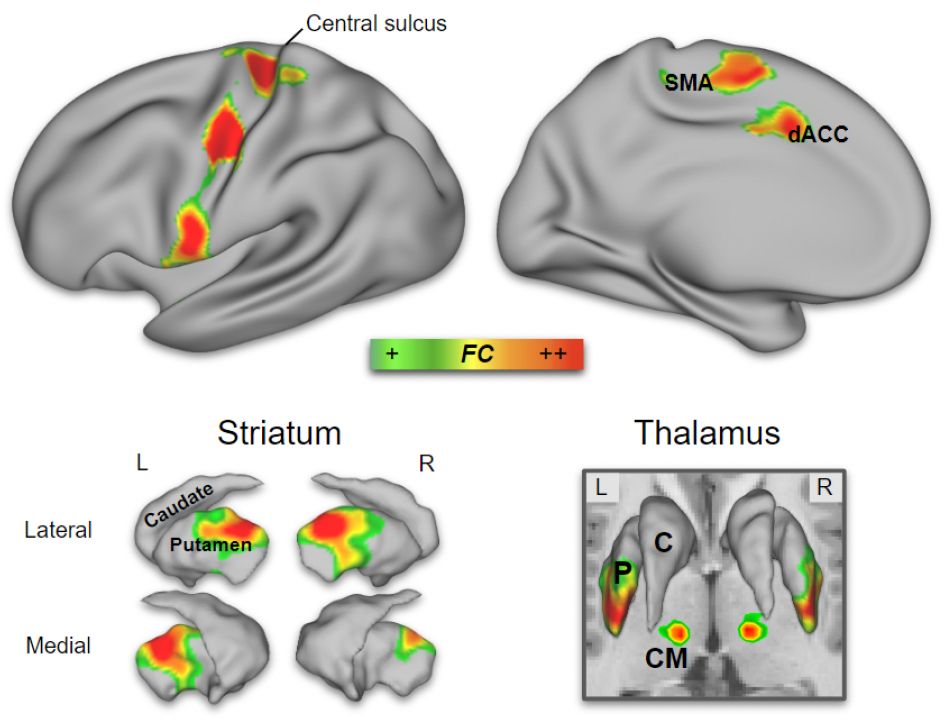
June 26, 2025 at 1:29 PM
Alert!!!!
“An Action Networks Model for Pain”
We propose a new model for chronic pain — and highlight two functionally connected cortical networks that could revolutionize how we treat it.
👉 thread below 🧵
osf.io/preprints/ps...
“An Action Networks Model for Pain”
We propose a new model for chronic pain — and highlight two functionally connected cortical networks that could revolutionize how we treat it.
👉 thread below 🧵
osf.io/preprints/ps...
Reposted by Suhwan Gim
Big year for our lab at #OHBM2025!
Thrilled to present an exciting mix of posters, talks, and lots of brainy fun 🧠🤓
Come check us out! We’d love to connect!
@cognizelab.bsky.social
@ohbmofficial.bsky.social
#OHBM #OHBM2025 #Neuroimaging
Thrilled to present an exciting mix of posters, talks, and lots of brainy fun 🧠🤓
Come check us out! We’d love to connect!
@cognizelab.bsky.social
@ohbmofficial.bsky.social
#OHBM #OHBM2025 #Neuroimaging
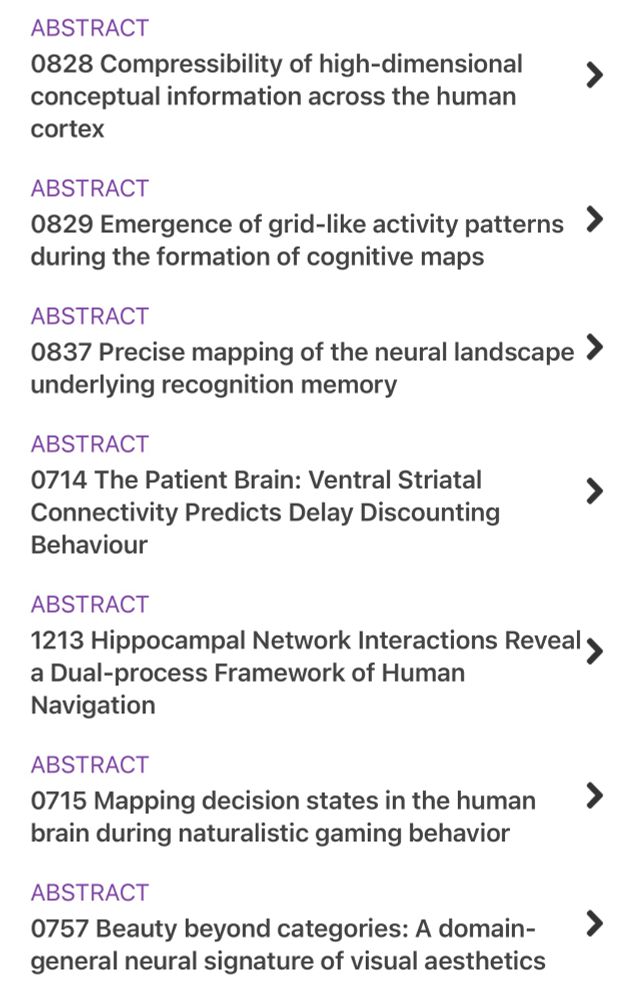
June 25, 2025 at 12:05 AM
Big year for our lab at #OHBM2025!
Thrilled to present an exciting mix of posters, talks, and lots of brainy fun 🧠🤓
Come check us out! We’d love to connect!
@cognizelab.bsky.social
@ohbmofficial.bsky.social
#OHBM #OHBM2025 #Neuroimaging
Thrilled to present an exciting mix of posters, talks, and lots of brainy fun 🧠🤓
Come check us out! We’d love to connect!
@cognizelab.bsky.social
@ohbmofficial.bsky.social
#OHBM #OHBM2025 #Neuroimaging
Reposted by Suhwan Gim
Does your favorite song actually relieve pain?
We looked into the brain to find out. 🧠🎶❓
Come check out Poster #0780 (Wed/Thur) at #OHBM2025!
In collaboration with McGill University — Elise Desbarats & Prof. Mathieu Roy.
We looked into the brain to find out. 🧠🎶❓
Come check out Poster #0780 (Wed/Thur) at #OHBM2025!
In collaboration with McGill University — Elise Desbarats & Prof. Mathieu Roy.

June 24, 2025 at 11:02 PM
Does your favorite song actually relieve pain?
We looked into the brain to find out. 🧠🎶❓
Come check out Poster #0780 (Wed/Thur) at #OHBM2025!
In collaboration with McGill University — Elise Desbarats & Prof. Mathieu Roy.
We looked into the brain to find out. 🧠🎶❓
Come check out Poster #0780 (Wed/Thur) at #OHBM2025!
In collaboration with McGill University — Elise Desbarats & Prof. Mathieu Roy.
Reposted by Suhwan Gim
🧠📖 New paper out! How does the brain make sense of a story?
Combining behavioral data, #fMRI, and #LLMs, our study explores how distinct hippocampal-cortical systems support the #encoding and #sequencing of #narrative events during ongoing comprehension.
www.nature.com/articles/s42...
Combining behavioral data, #fMRI, and #LLMs, our study explores how distinct hippocampal-cortical systems support the #encoding and #sequencing of #narrative events during ongoing comprehension.
www.nature.com/articles/s42...
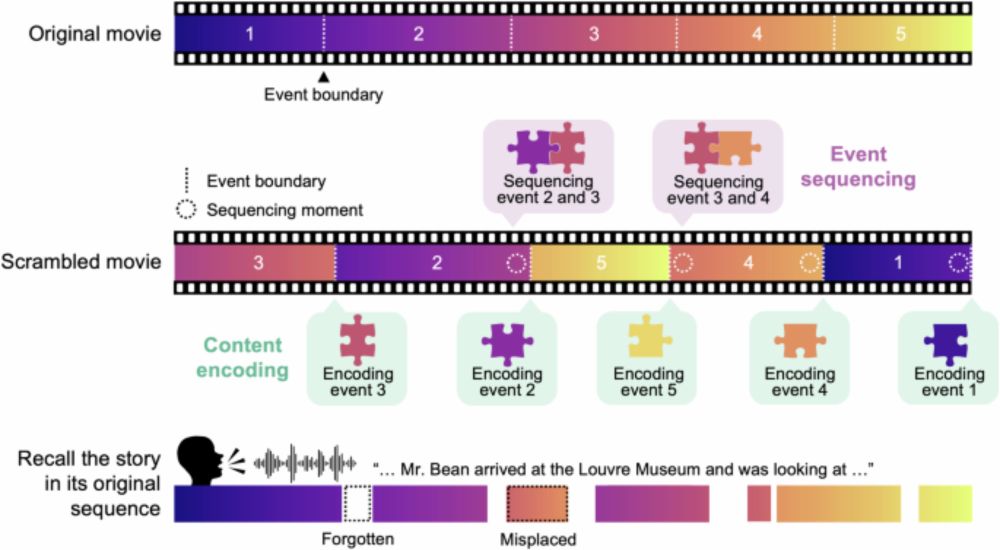
Hippocampal systems for event encoding and sequencing during ongoing narrative comprehension - Communications Biology
Distinct hippocampal-cortical systems support the encoding and sequencing of narrative events during ongoing comprehension, revealing how episodic memory integrates past and present information into c...
www.nature.com
June 23, 2025 at 11:09 PM
🧠📖 New paper out! How does the brain make sense of a story?
Combining behavioral data, #fMRI, and #LLMs, our study explores how distinct hippocampal-cortical systems support the #encoding and #sequencing of #narrative events during ongoing comprehension.
www.nature.com/articles/s42...
Combining behavioral data, #fMRI, and #LLMs, our study explores how distinct hippocampal-cortical systems support the #encoding and #sequencing of #narrative events during ongoing comprehension.
www.nature.com/articles/s42...
Reposted by Suhwan Gim
Our new @NatureHumBehav paper shows why we need a holistic pain biomarker framework. ML on blood tests, brain/bone imaging & genetics predicts clinical diagnoses but falls short on subjective pain. Adding psychosocial (mood, sleep, stress) boosts both. shorturl.at/vxxeO
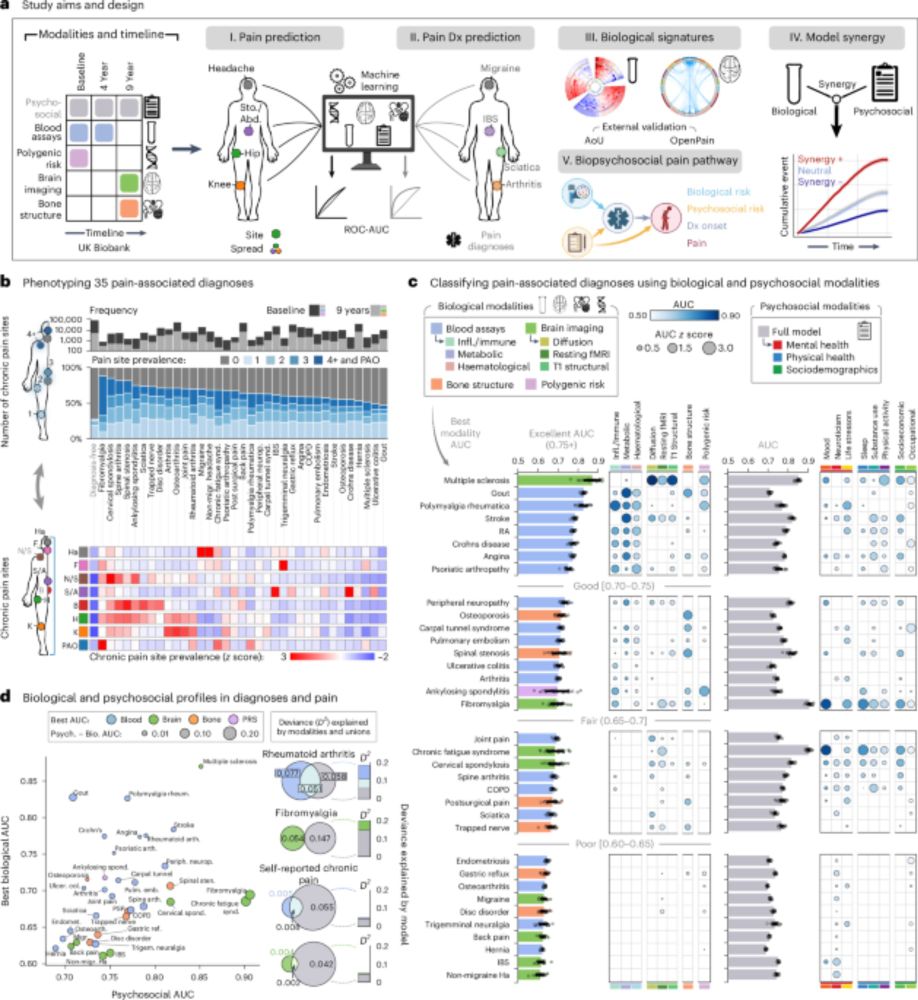
Biological markers and psychosocial factors predict chronic pain conditions - Nature Human Behaviour
Fillingim et al. show that biological and psychosocial factors jointly predict conditions associated with chronic pain.
shorturl.at
May 12, 2025 at 3:51 PM
Our new @NatureHumBehav paper shows why we need a holistic pain biomarker framework. ML on blood tests, brain/bone imaging & genetics predicts clinical diagnoses but falls short on subjective pain. Adding psychosocial (mood, sleep, stress) boosts both. shorturl.at/vxxeO
Reposted by Suhwan Gim
Dreaming of a dataset that tracks mood, sleep & activity to better understand affective instability (AI)…AND paired with advanced MRI? 🤯
Check out our new bioRxiv preprint for a 13–23 y/o community sample (n=10 and growing!) with multi-echo fMRI, EMA & actigraphy: www.biorxiv.org/content/10.1...
Check out our new bioRxiv preprint for a 13–23 y/o community sample (n=10 and growing!) with multi-echo fMRI, EMA & actigraphy: www.biorxiv.org/content/10.1...
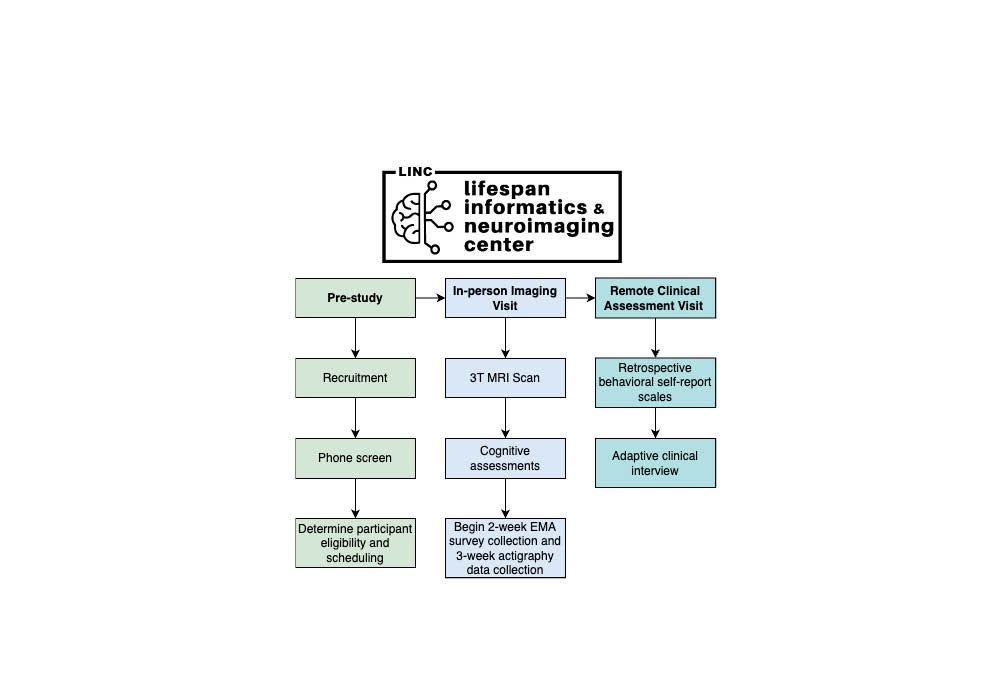
May 6, 2025 at 3:32 PM
Dreaming of a dataset that tracks mood, sleep & activity to better understand affective instability (AI)…AND paired with advanced MRI? 🤯
Check out our new bioRxiv preprint for a 13–23 y/o community sample (n=10 and growing!) with multi-echo fMRI, EMA & actigraphy: www.biorxiv.org/content/10.1...
Check out our new bioRxiv preprint for a 13–23 y/o community sample (n=10 and growing!) with multi-echo fMRI, EMA & actigraphy: www.biorxiv.org/content/10.1...
Reposted by Suhwan Gim
Hi, I’m very pleased to share my social memory project with my PI Won Mok Shim and amazing collaborators @myoo.bsky.social
www.nature.com/articles/s41...
How does the hippocampus integrate multiple cognitive processes for memory encoding and retrieval?🧠
Here’s what we found⬇️:
www.nature.com/articles/s41...
How does the hippocampus integrate multiple cognitive processes for memory encoding and retrieval?🧠
Here’s what we found⬇️:

Coordinated representations for naturalistic memory encoding and retrieval in hippocampal neural subspaces - Nature Communications
In this study, the authors show that novelty encoding aligns with memory formation in the hippocampus but not with memory retrieval, and that hippocampal components involved in each process reflect it...
www.nature.com
January 28, 2025 at 7:21 AM
Hi, I’m very pleased to share my social memory project with my PI Won Mok Shim and amazing collaborators @myoo.bsky.social
www.nature.com/articles/s41...
How does the hippocampus integrate multiple cognitive processes for memory encoding and retrieval?🧠
Here’s what we found⬇️:
www.nature.com/articles/s41...
How does the hippocampus integrate multiple cognitive processes for memory encoding and retrieval?🧠
Here’s what we found⬇️:
Reposted by Suhwan Gim
This paper is magical.
Three must read papers for PhD students. #scisky #PhD #science #research #academicsky
1. The importance of stupidity in scientific research
Open Access
journals.biologists.com/jcs/article/...
1. The importance of stupidity in scientific research
Open Access
journals.biologists.com/jcs/article/...
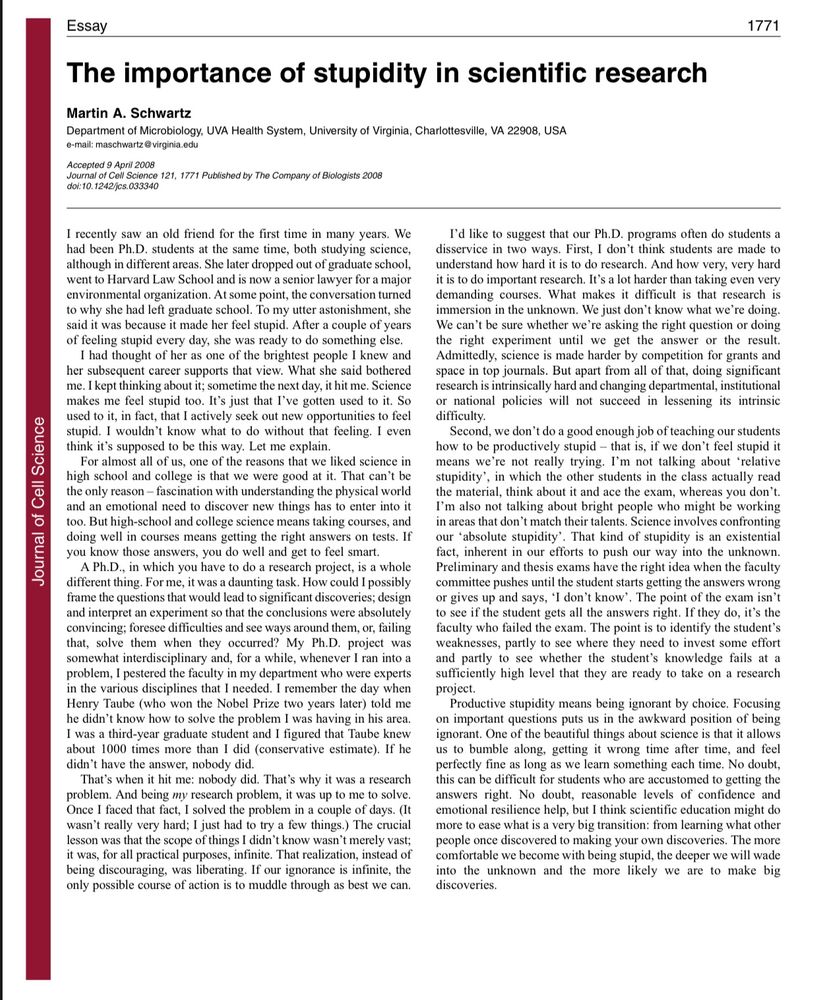
December 15, 2024 at 12:37 PM
This paper is magical.
Reposted by Suhwan Gim
1/ 🧵 Free resources for scientists
💡 Covering research skills, careers, #SciComm, leadership, activism and more, everything in this thread appears on our Learning Resources page, with tips for researchers and academics at any career stage. #AcademicChatter #ECRChat
https://buff.ly/4f8vIpk
💡 Covering research skills, careers, #SciComm, leadership, activism and more, everything in this thread appears on our Learning Resources page, with tips for researchers and academics at any career stage. #AcademicChatter #ECRChat
https://buff.ly/4f8vIpk
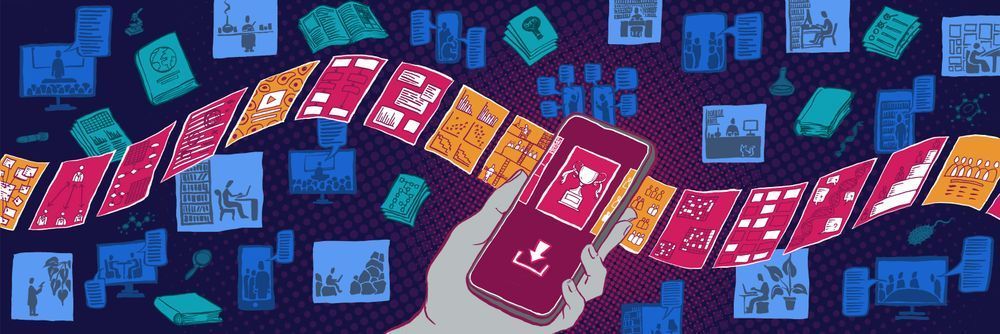
Learning resources for scientists · eLife
A collections of articles that provide practical resources and guidance for researchers and academics
buff.ly
November 26, 2024 at 3:42 PM
1/ 🧵 Free resources for scientists
💡 Covering research skills, careers, #SciComm, leadership, activism and more, everything in this thread appears on our Learning Resources page, with tips for researchers and academics at any career stage. #AcademicChatter #ECRChat
https://buff.ly/4f8vIpk
💡 Covering research skills, careers, #SciComm, leadership, activism and more, everything in this thread appears on our Learning Resources page, with tips for researchers and academics at any career stage. #AcademicChatter #ECRChat
https://buff.ly/4f8vIpk
😄The final version of my first Ph.D. project is published in PLOS Biology. We showed the spatiotemporal profile of how the brain mediates cue-stimulus integration in pain, interpreting the findings in terms of cortical hierarchy from association to sensorimotor systems. plos.io/4fsaanu

Spatiotemporal integration of contextual and sensory information within the cortical hierarchy in human pain experience
When we experience pain, the sensory input is modulated by contextual information. This neuroimaging study shows how expectation and sensory input are integrated in the human brain during pain percept...
plos.io
November 29, 2024 at 1:23 PM
😄The final version of my first Ph.D. project is published in PLOS Biology. We showed the spatiotemporal profile of how the brain mediates cue-stimulus integration in pain, interpreting the findings in terms of cortical hierarchy from association to sensorimotor systems. plos.io/4fsaanu
Finally,😃 the first project during the Ph.D. program is published in PLOS Biology. We examined the spatiotemporal brain dynamics of context and sensory information integration in pain.
Thanks to my advisor @choongwanwoo.bsky.social and co-authors Seok-Jun Hong and Elizabeth Losin. plos.io/4fsaanu
Thanks to my advisor @choongwanwoo.bsky.social and co-authors Seok-Jun Hong and Elizabeth Losin. plos.io/4fsaanu
November 16, 2024 at 3:07 AM
Finally,😃 the first project during the Ph.D. program is published in PLOS Biology. We examined the spatiotemporal brain dynamics of context and sensory information integration in pain.
Thanks to my advisor @choongwanwoo.bsky.social and co-authors Seok-Jun Hong and Elizabeth Losin. plos.io/4fsaanu
Thanks to my advisor @choongwanwoo.bsky.social and co-authors Seok-Jun Hong and Elizabeth Losin. plos.io/4fsaanu
Reposted by Suhwan Gim
📢 Exciting news! My first first-author paper on brain decoding of spontaneous thought is now available on PNAS. Check it out! www.pnas.org/doi/10.1073/...
✅ Summary: We developed fMRI-based predictive models of spontaneous thought using personal stories as stimuli. (1/4)
✅ Summary: We developed fMRI-based predictive models of spontaneous thought using personal stories as stimuli. (1/4)
PNAS
Proceedings of the National Academy of Sciences (PNAS), a peer reviewed journal of the National Academy of Sciences (NAS) - an authoritative source of high-impact, original research that broadly spans...
www.pnas.org
March 30, 2024 at 5:45 AM
📢 Exciting news! My first first-author paper on brain decoding of spontaneous thought is now available on PNAS. Check it out! www.pnas.org/doi/10.1073/...
✅ Summary: We developed fMRI-based predictive models of spontaneous thought using personal stories as stimuli. (1/4)
✅ Summary: We developed fMRI-based predictive models of spontaneous thought using personal stories as stimuli. (1/4)
Hi, I’m very pleased to share the preprint of my first project with my PI @choongwanwoo.bsky.social and amazing collaborators Seok-Jun Hong and E.A.R. Losin.
Here we examined the behavioral and neural dynamics of pain as a continuous integration process (1/8)
www.biorxiv.org/content/10.1...
Here we examined the behavioral and neural dynamics of pain as a continuous integration process (1/8)
www.biorxiv.org/content/10.1...

Temporal Dynamics of Brain Mediation in Predictive Cue-induced Pain Modulation
bioRxiv - the preprint server for biology, operated by Cold Spring Harbor Laboratory, a research and educational institution
www.biorxiv.org
January 26, 2024 at 12:54 AM
Hi, I’m very pleased to share the preprint of my first project with my PI @choongwanwoo.bsky.social and amazing collaborators Seok-Jun Hong and E.A.R. Losin.
Here we examined the behavioral and neural dynamics of pain as a continuous integration process (1/8)
www.biorxiv.org/content/10.1...
Here we examined the behavioral and neural dynamics of pain as a continuous integration process (1/8)
www.biorxiv.org/content/10.1...

